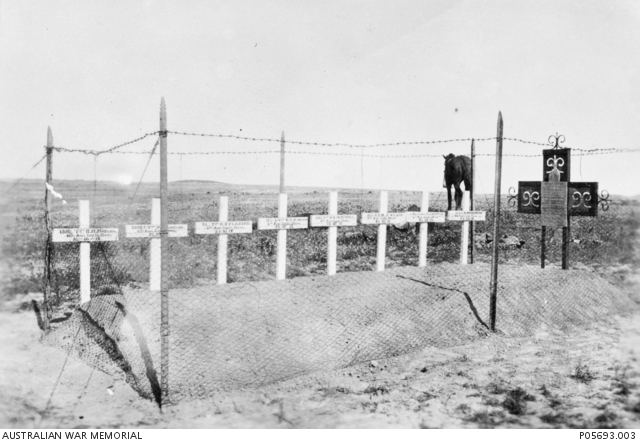| Accession Number | P05693.003 |
|---|---|
| Collection type | Photograph |
| Object type | Black & white - Print silver gelatin |
| Maker |
Unknown |
| Place made | Ottoman Empire: Palestine, Beersheba |
| Date made | February 1918-March 1918 |
| Conflict |
First World War, 1914-1918 |
| Copyright |
Item copyright: Copyright expired - public domain
|
Graves of casualties including 91 Private (Pte) Edward Randolph Cleaver, 4th Light Horse Regiment ...

Graves of casualties including 91 Private (Pte) Edward Randolph Cleaver, 4th Light Horse Regiment (4LHR) who fell at Beersheba, Palestine, 31 October 1917. The metal plate from the grave marker (to the right of the image) is held in the collection of the Australian War Memorial. This grave marker, made by Warrant Officer 2 James Isaac (Jim) French, of the 4th Light Horse Regiment, from material cut from an old tank, was placed on an ornamental cross made by local Palestinian craftsmen, which marked the position of the mass grave for the eleven members of the regiment who had been killed in the charge at Beersheba on 31 October 1917. According to a letter written in July 1918 by French's father to Miss Cleaver, the sister of Trooper Cleaver who is listed on the plaque, Jim French was given permission to travel from Gaza to Beersheba with a small party of men to erect the marker and other wooden crosses in the cemetery. Evidence from the regiment's War Diary suggests that this must have occurred at the end of February or beginning of March 1918 when the regiment spent nearly three weeks in the Gaza area engaged in 'salvage' work. The bodies in the mass grave were exhumed by the Imperial War Graves Commission in Palestine in 1924 and given individual graves in the Beersheba War Cemetery, on the same site as the original cemetery, which had been made immediately after the fall of the town in 1917. The plate which had marked the mass grave was forwarded to the Australia for preservation. French's father thought that his son had also made the ornamental backing cross on which the marker was placed but as the pattern is typical of Palestinian craftsmanship of the period this seems unlikely. French assumed that all eleven men who had died in the Charge had been killed in action and marked his plaque to this effect. In fact, three men died of wounds soon afterwards. One of these was Trooper Harold Thomas Wickham, who may have been the youngest light horseman to die in Palestine. Claiming to be a 21 year old farmer, he had enlisted in Victoria in March 1917 under the alias surname Wickham, naming his 'uncle' (in fact his father), Thomas Bell, as his next of kin. Wickham was sixteen when he died on 1 November 1917 from the effects of Turkish machine gun fire sustained during the Charge, which had resulted in multiple fractures and blood loss in one leg.
